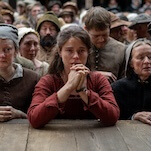Now this, this is more like it. After a pilot that offered promise and tested patience, the easiest way for Black Sails to get good—though not necessarily great—would be to accelerate the plot. Even we don't really like the characters or aren't terribly interested in the story, shifting into hyperserialization allows the show to work quickly to help us, and it, find the best parts of it. Being so fast-paced works at two levels: it lets us see the characters react to stressful situations, and it allows the show put to more different characters in different situations. Eventually, a breakout character, a fine bit of actor chemistry, or a really fruitful storyline can be found. And until then, the simplest motive of “I want to see what happens next” should maintain most interest.
The key element of making this kind of hyperserialization work is that we can't feel like the show is jerking us around. That happens most often when a show has its characters withhold critical information from us, the viewers, or from each other, for no real reason other than to artificially inflate the drama (hellllooo Helix). Black Sails flirted with this at the start of its pilot, so I was surprised and pleased to see that its second episode demonstrated its characters showing intelligence and figuring out one of the mysteries driving the premise.
That's the question of where the treasure galleon schedule is. The premiere ended with Flint and Billy conspiring to pretend they had in order to buy time, while John Silver wanted to hide it and sell it. But as soon as they, and First Mate Gates, start to talk about it, they realize that Silver is the only likely culprit, and head out after him. So many TV shows depend on characters not putting two and two together and realizing that the oddly-behaving new guy could be a problem until it's too late, that this was downright impressive.
It also set up an entertaining hour of television. Four of the five known factions all started bouncing off one another, setting up alliance, making their plays. Silver and Max are attempting to make their sale to Vane's crew members Anne Bonny and Jack Rackham. Flint, Billy, and Gates are attempting to get to Silver before the deal can go down. And Eleanor Guthrie is caught in the middle, being wooed by Max's personal appeals and Flint's political ambitions. (The fifth faction we were introduced to, the British government, doesn't have a presence in “II.”) The episode is well-paced so that the chase never turns boring, shifting from running to hiding to negotiating and back again. But it also takes the time to breathe and let the characters become more interesting.
The most surprising character to benefit from this is Captain Vane. Introduced as a steely, brutal badass, he's swiftly given three dimensions in the course of the episode. In one scene, he goes to Eleanor in supplication, asking for more information on merchant schedules to capture them, and seems downright sad about the breakup—his little joke/threat for Eleanor's sake also indicated a personality. He's also more skeptical about the treasure galleon schedule, and motivated more by Calico Jack's threats and promises than actually wanting it himself. These scenes also indicate that Vane, like Flint, has his own internal struggles instead of simply leading the Evil Pirates with an iron fist. I also found myself liking the actor playing Calico Jack, although he's still two-dimensional as a character.
Eleanor Guthrie, along with Vane, was one of the broadest-drawn characters in the premiere, so giving the two of them the chance to act and make choices is a wise move for the show. In Eleanor's case, the moment when she's forced to decide whether she wants personal gain or political security gives us something to believe about the character, and a major source of tension for her going forward.
I also found the scene with Eleanor's choice fascinating for its connection to gender and race. Black Sails has the opportunity to examine such things outside of the bounds of history as the story of powerful white men, because we know these pirates are, at least in part, rejecting those hierarchies and institutions. And yet, here's a black woman kneeling in front of a white woman, begging for her power. The white woman, meanwhile, while technically more powerful than the men who burst in, still accedes to those demands. In other words, the show is maintaining conventional power hierarchies, but given Max's unhappiness with what happens, I'm not certain that we're supposed to believe that what happened was a satisfying resolution.
Now, I don't want to oversell “II” too much. Both adding depth to characters and moving the plot forward with momentum are good things, but they still don't change the core issue that Black Sails is largely lacking in charisma overall (other than the title credits). This episode felt like it was going through the motions of being a fun romp more than being a fun romp itself, especially in the early going. But that's okay right now, because it's a show finding its footing. All it has to do is be entertaining enough not to lose its audience, and eventually, what could be great has a chance to emerge. That seems more likely this week than it did last week.
Stray observations:
- “We don't like thieves” says the former cook repeatedly, which initially led me to believe the entire episode would be John Silver being tormented into morality.
- “I was careful.” “Careful! You just told me you'd been caught!” Fun interaction here. I feel like Luke Arnold could be surprisingly good as John Silver.
- Flint's Odysseus metaphor for his goals was a bit of slow-paced intelligence for a show that had seemed unmotivated to be that way.
- “But he's using a whore as a go-between…” Another case of characters demonstrating intelligence: Eleanor figures out that it's Max.
- “Please. There's in there but opium addicts, lunatics, men who thought themselves too good to wear a condom.” Calico Jack may be the potential breakout character. I just love his line delivery, like he's a voice actor for a real person.
- What was up with the ending? Flint puts on his battle gear, watches a night party/orgy, then collapses in a house? I guess it's been a long day, but it felt like there was some sort of scene or explanation missing.
- Interesting mix of the fictional and historical. Vance, Anne Bonny, and Calico Jack are all real characters, while Flint's crew is more of a Treasure Island prequel.








































